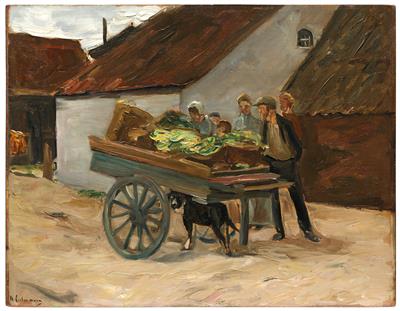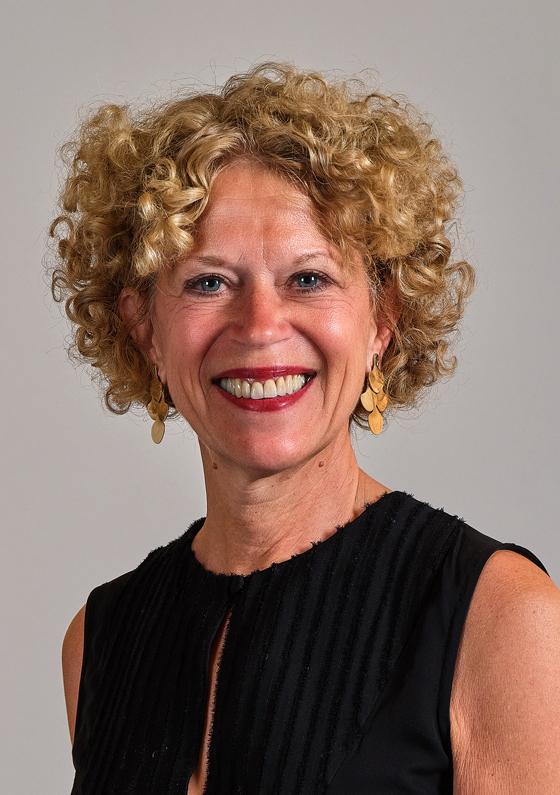Max Liebermann

(Berlin 1849–1935)
Vegetable barrow – dog cart, 1906, signed M. Liebermann,
oil on wood, parquetted, 54.5 x 69.8 cm, framed
Provenance:
Philipp Freudenberg (1833–1919), Berlin (until 1909)
Paul Cassirer, Berlin (acquired in 25.10.1909, PC no. 1276, 1914)
Galerie Thannhauser, Munich (acquired from Paul Cassirer in 8.3.1917)
Tilla Durieux (1880–1971), Berlin 1923
Leclerc Family, Hamburg – Munich
Neumeister Auktionen, Munich, 16.4.1980, lot 1390
Collection Hans Georg Karg (1922–2003), Grabenstätt Germany,
c. 1980 until at least 2005
Galerie Michael Haas, Berlin
Galerie Bierhinkel, Baden-Baden
Private Collection, Southern Germany – acquired from the above in 2010
Exhibited:
Moderne Galerie Thannhauser, Munich July 1917, no. 65 (ill.)
Literature:
Matthias Eberle, Max Liebermann 1847–1935, Werkverzeichnis der Gemälde und Ölstudien, vol 2, 1900- 1935, Munich 1995, no. 1906/10,
p. 675, col. ill. p 673
Erich Hanke, Mit Liebermann in Amsterdam, in: Kunst und Künstler, ed. XII, 1913, vol. 1, p. 9–21, ill.. p 14
Erich Hancke, Max Liebermann. Sein Leben und seine Werke, Berlin 1914 & 1923, with the catalogue raisonné of the paintings and pastels up to 1913, p. 542 (as “auf Leinwand”), ill. p. 431 Weltkunst, ed. L, 1980, no. 7, ill. p. 901
The Karg Collection, A Sale of Important Works by Max Liebermann, Munich 2005, p. 55
“Oh happy times, when we were allowed to spend a few months each year in Holland enjoying and working, working and enjoying”.
(Max Liebermann)
In the works of Max Liebermann, the harmony and togetherness of man and his environment played an increasingly important role from the 1890s onwards. Through his style of painting and by implementing his preferred motifs of the bourgeois world, the lively beaches, streets and squares, Max Liebermann became one of the main representatives of German Impressionism. Colour takes on a life of its own in his paintings, whilst remaining committed to the model of nature. In contrast to the works that were created before and around the turn of the century, Max Liebermann’s treatment of light changes in works such as the present work. The light is no longer used objectively and motifically and set in individual sunspots, but in the works from around 1905 onwards it spreads as a mild soft film of colour over the sunlit surface.
With the paintings that Max Liebermann entitled “Judengasse”, which he began to paint from 1905 onwards at the suggestion of the director of the Amsterdam Academy of Art, he dealt with the simple, bourgeois life and the bustling activity of trading on the street. With the “vegetable cart”, Max Liebermann picks out a village solitaire of the large markets in Amsterdam. With broad brushstrokes he captures the simply structured, calm scene. The greengrocer, dressed in black, closely follows the movements of the women, one of whom wears a traditional Dutch bonnet, and checks his range of goods. The physiognomy of the individual faces fades into the background in favour of the overall view of the activity of those portrayed. The viewer’s attention is drawn to the baskets richly laden with vegetables, which Max Liebermann captures in light shades of green and broad brushwork. He depicts the wagon at an angle so that we, as viewers, are offered the goods for sale. The black and white dog standing in the shade under the cart looks directly out of the picture and additionally demands the full attention of the observer. The section of the whitewashed house behind the cart, as well as the brown and grey shed standing perpendicularly in the left background of the picture delimit the pictorial space, thus proving to be both modern and breaking the boundaries of the format. With this constructive refinement, Max Liebermann moves the scene on the vegetable cart into a very small area of activity and presents it straight to the viewer. The gaze cannot wander into the distance, but is automatically directed towards the central main event in the foreground of the work, the houses and the sky in the background merely serving as a decorative boundary for the pictorial space.
Expert: Dr. Petra Maria Schäpers
 Dr. Petra Maria Schäpers
Dr. Petra Maria Schäpers
+49 211 2107747
petra.schaepers@dorotheum.de
23.06.2020 - 16:00
- Dosažená cena: **
-
EUR 106.550,-
- Odhadní cena:
-
EUR 100.000,- do EUR 150.000,-
Max Liebermann
(Berlin 1849–1935)
Vegetable barrow – dog cart, 1906, signed M. Liebermann,
oil on wood, parquetted, 54.5 x 69.8 cm, framed
Provenance:
Philipp Freudenberg (1833–1919), Berlin (until 1909)
Paul Cassirer, Berlin (acquired in 25.10.1909, PC no. 1276, 1914)
Galerie Thannhauser, Munich (acquired from Paul Cassirer in 8.3.1917)
Tilla Durieux (1880–1971), Berlin 1923
Leclerc Family, Hamburg – Munich
Neumeister Auktionen, Munich, 16.4.1980, lot 1390
Collection Hans Georg Karg (1922–2003), Grabenstätt Germany,
c. 1980 until at least 2005
Galerie Michael Haas, Berlin
Galerie Bierhinkel, Baden-Baden
Private Collection, Southern Germany – acquired from the above in 2010
Exhibited:
Moderne Galerie Thannhauser, Munich July 1917, no. 65 (ill.)
Literature:
Matthias Eberle, Max Liebermann 1847–1935, Werkverzeichnis der Gemälde und Ölstudien, vol 2, 1900- 1935, Munich 1995, no. 1906/10,
p. 675, col. ill. p 673
Erich Hanke, Mit Liebermann in Amsterdam, in: Kunst und Künstler, ed. XII, 1913, vol. 1, p. 9–21, ill.. p 14
Erich Hancke, Max Liebermann. Sein Leben und seine Werke, Berlin 1914 & 1923, with the catalogue raisonné of the paintings and pastels up to 1913, p. 542 (as “auf Leinwand”), ill. p. 431 Weltkunst, ed. L, 1980, no. 7, ill. p. 901
The Karg Collection, A Sale of Important Works by Max Liebermann, Munich 2005, p. 55
“Oh happy times, when we were allowed to spend a few months each year in Holland enjoying and working, working and enjoying”.
(Max Liebermann)
In the works of Max Liebermann, the harmony and togetherness of man and his environment played an increasingly important role from the 1890s onwards. Through his style of painting and by implementing his preferred motifs of the bourgeois world, the lively beaches, streets and squares, Max Liebermann became one of the main representatives of German Impressionism. Colour takes on a life of its own in his paintings, whilst remaining committed to the model of nature. In contrast to the works that were created before and around the turn of the century, Max Liebermann’s treatment of light changes in works such as the present work. The light is no longer used objectively and motifically and set in individual sunspots, but in the works from around 1905 onwards it spreads as a mild soft film of colour over the sunlit surface.
With the paintings that Max Liebermann entitled “Judengasse”, which he began to paint from 1905 onwards at the suggestion of the director of the Amsterdam Academy of Art, he dealt with the simple, bourgeois life and the bustling activity of trading on the street. With the “vegetable cart”, Max Liebermann picks out a village solitaire of the large markets in Amsterdam. With broad brushstrokes he captures the simply structured, calm scene. The greengrocer, dressed in black, closely follows the movements of the women, one of whom wears a traditional Dutch bonnet, and checks his range of goods. The physiognomy of the individual faces fades into the background in favour of the overall view of the activity of those portrayed. The viewer’s attention is drawn to the baskets richly laden with vegetables, which Max Liebermann captures in light shades of green and broad brushwork. He depicts the wagon at an angle so that we, as viewers, are offered the goods for sale. The black and white dog standing in the shade under the cart looks directly out of the picture and additionally demands the full attention of the observer. The section of the whitewashed house behind the cart, as well as the brown and grey shed standing perpendicularly in the left background of the picture delimit the pictorial space, thus proving to be both modern and breaking the boundaries of the format. With this constructive refinement, Max Liebermann moves the scene on the vegetable cart into a very small area of activity and presents it straight to the viewer. The gaze cannot wander into the distance, but is automatically directed towards the central main event in the foreground of the work, the houses and the sky in the background merely serving as a decorative boundary for the pictorial space.
Expert: Dr. Petra Maria Schäpers
 Dr. Petra Maria Schäpers
Dr. Petra Maria Schäpers
+49 211 2107747
petra.schaepers@dorotheum.de
|
Horká linka kupujících
Po-Pá: 10.00 - 17.00
kundendienst@dorotheum.at +43 1 515 60 200 |
| Aukce: | Moderní |
| Typ aukce: | Salónní aukce |
| Datum: | 23.06.2020 - 16:00 |
| Místo konání aukce: | Wien | Palais Dorotheum |
| Prohlídka: | 18.06. - 23.06.2020 |
** Kupní cena vč. poplatku kupujícího a DPH
Není již možné podávat příkazy ke koupi přes internet. Aukce se právě připravuje resp. byla již uskutečněna.
